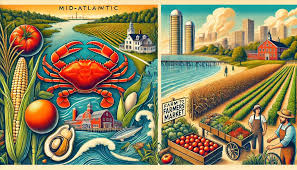The Mid-Atlantic region of the United States is a unique and diverse area that encompasses a rich history, diverse landscapes, and vibrant cultural traditions. This region includes major cities like New York, Philadelphia, Washington D.C., and Baltimore, and spans across states such as New York, New Jersey, Pennsylvania, Delaware, Maryland, and Virginia. The geography of the Mid-Atlantic has significantly shaped its culinary identity, and the region’s food culture reflects its history, agriculture, and access to various natural resources.
In this article, we will explore how the Mid-Atlantic’s geography influences the food culture of the region, highlighting the unique flavors, ingredients, and culinary traditions that define the area.
Understanding the Mid-Atlantic Geography
The Mid-Atlantic sits in the northeastern part of the United States, bordered by the Atlantic Ocean to the east and stretching inland to the Appalachian Mountains. This diverse geography includes bustling urban areas, agricultural lands, coastal regions, and mountainous terrains. The region’s proximity to the ocean has made it an ideal location for fishing, while fertile farmland has supported a rich agricultural tradition. The Mid-Atlantic’s climate, a mix of humid subtropical and humid continental, contributes to diverse crops and an abundance of seasonal produce.
Some of the key geographical features of the Mid-Atlantic region include:
- Coastal Areas: The coastal regions, especially around New Jersey, Delaware, and Maryland, provide abundant access to seafood. Fishermen in these areas harvest a wide range of shellfish, including crabs, oysters, and clams. The Chesapeake Bay, in particular, is known for its blue crabs and oysters, which have become staples of Mid-Atlantic cuisine.
- Farmland: The fertile lands of Pennsylvania and parts of New Jersey support large-scale agriculture. These regions are known for producing grains, dairy products, and vegetables. The availability of local produce, such as apples, corn, tomatoes, and potatoes, has had a significant impact on regional food traditions.
- Mountains and Forests: The Appalachian Mountain range and the surrounding forests offer an abundance of wild game, mushrooms, berries, and herbs. The region’s mountainous terrain also makes it ideal for producing apples and certain types of berries that are often featured in traditional desserts and preserves.
- Urban Centers: Cities like New York and Philadelphia have long been melting pots of diverse cultures, which have influenced the region’s food culture. These urban areas boast an exciting range of international cuisines, from Italian and Jewish influences in New York’s food scene to the African American and Quaker contributions to Philadelphia’s culinary history.
The Influence of Geography on Mid-Atlantic Cuisine
The geographic features of the Mid-Atlantic region have led to the development of a distinctive and flavorful food culture. Let’s explore some of the key elements of the region’s cuisine and how its geography has shaped these culinary traditions.
1. Seafood and Coastal Flavors
The coastal areas of the Mid-Atlantic are known for their seafood, which plays a major role in regional dishes. The Chesapeake Bay, one of the largest estuaries in the U.S., is home to blue crabs, which are a key ingredient in many Mid-Atlantic dishes. Crab cakes, a beloved regional dish, consist of blue crab meat mixed with breadcrumbs, mayonnaise, and seasonings, then fried until golden brown. Other seafood favorites in the Mid-Atlantic include oysters, clams, and mussels, often featured in chowders, steamed dishes, or served on the half shell.
Another iconic seafood dish of the Mid-Atlantic is the “Old Bay” seasoned shrimp, which originates from the Chesapeake Bay region. Old Bay is a distinctive spice blend that has become a signature flavor in Mid-Atlantic seafood cuisine.
2. Farm-to-Table Tradition and Agricultural Influence
The fertile farmlands of Pennsylvania, New Jersey, and parts of Maryland have had a profound impact on the region’s cuisine. The farm-to-table movement, which emphasizes locally grown, seasonal produce, is deeply embedded in the Mid-Atlantic’s food culture. The region is known for its fresh vegetables, such as corn, tomatoes, pumpkins, and squash, which appear in a variety of dishes. Apples are another important crop in the Mid-Atlantic, with the region being famous for varieties like the Red Delicious and Gala apples.
In addition to fruits and vegetables, dairy products are also a key part of the region’s food culture. Pennsylvania is known for its dairy farms, which produce high-quality cheeses and dairy products. The “Pennsylvania Dutch” community, with its strong German heritage, has influenced the region’s food with hearty, dairy-laden dishes such as creamy mashed potatoes, butter-rich breads, and cheese-filled pastries.
3. Influence of Immigrant Communities
The Mid-Atlantic’s large cities, especially New York and Philadelphia, have long been melting pots of diverse cultures. Immigrant groups, including Italians, Jews, Germans, and Irish, have brought their culinary traditions to the region. The result is a fusion of flavors that has shaped the food scene in urban areas.
- Italian Influence: New York City’s Little Italy neighborhood has long been famous for its Italian food. Dishes like pizza, pasta, and meatballs are staples, but the city’s Italian-American community has also popularized unique creations, such as the famous New York-style pizza and Italian sub sandwiches.
- Jewish Influence: The Jewish community in the Mid-Atlantic has made significant contributions to regional cuisine, particularly in New York and Philadelphia. Dishes such as bagels, lox, and smoked fish have become beloved staples. The classic New York deli sandwich, loaded with pastrami or corned beef, is another example of Jewish influence in the region’s food culture.
- German Influence: The Pennsylvania Dutch, an Amish and German immigrant community, has had a lasting impact on the region’s food culture. Popular German-inspired dishes include pretzels, sausages, and hearty stews. Pennsylvania Dutch “shoofly pie,” made with molasses and a crumbly topping, is a well-known dessert that originated in the area.
4. Mountain Cuisine and Game Meats
The mountainous regions of the Mid-Atlantic, particularly in Appalachia, are known for hearty, rustic meals that often feature wild game. Venison, wild turkey, and rabbit are commonly used in traditional mountain dishes. The region’s forests also provide an abundance of mushrooms, which are used in soups, stews, and sauces.
Apple-based dishes are another important part of the mountain cuisine, with apple butter, apple cider, and apple pies all popular in the region. The rolling hills and mountain slopes create a perfect environment for apple orchards, making apples one of the Mid-Atlantic’s signature ingredients.
5. Distinctive Regional Dishes
Several dishes are deeply associated with the Mid-Atlantic region, shaped by its unique geography and cultural influences. Some of these iconic dishes include:
- Philly Cheesesteak: This iconic sandwich, originating in Philadelphia, consists of thinly sliced beefsteak, sautéed onions, and melted cheese, all served on a hoagie roll. While variations exist, the cheesesteak is synonymous with Philly’s food scene.
- Soft Pretzels: Soft pretzels, a classic snack in the Mid-Atlantic, are particularly popular in Pennsylvania, home of the Pennsylvania Dutch. These chewy, salty treats are often enjoyed with mustard and have become a staple at fairs, ballparks, and street corners.
- Scrapple: A traditional dish popular in Pennsylvania, scrapple is made from pork scraps, cornmeal, and spices, typically served as a breakfast item. It is often pan-fried and eaten with eggs or served alongside toast.
Conclusion
The Mid-Atlantic region’s geography has significantly influenced its culinary traditions. From coastal seafood to farm-fresh produce, and from immigrant influences to hearty mountain fare, the Mid-Atlantic is home to a diverse and rich food culture. Whether you’re indulging in a Philly cheesesteak, savoring fresh crab cakes, or enjoying a warm apple pie, the region’s geography has helped shape the delicious dishes that are beloved by locals and visitors alike.
The combination of natural resources, climate, and cultural exchange has created a unique culinary landscape that continues to evolve and thrive. By embracing the flavors and traditions of the Mid-Atlantic, you can experience the rich tapestry of history, geography, and food that defines this remarkable region.


